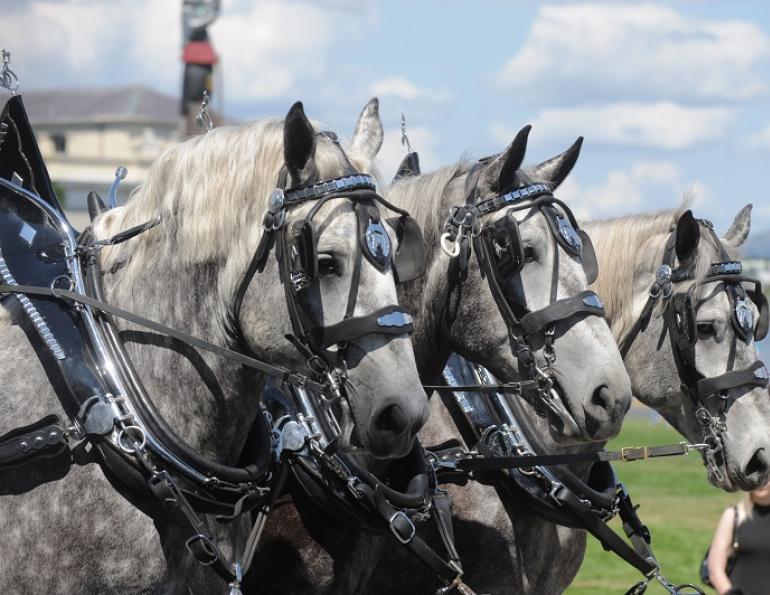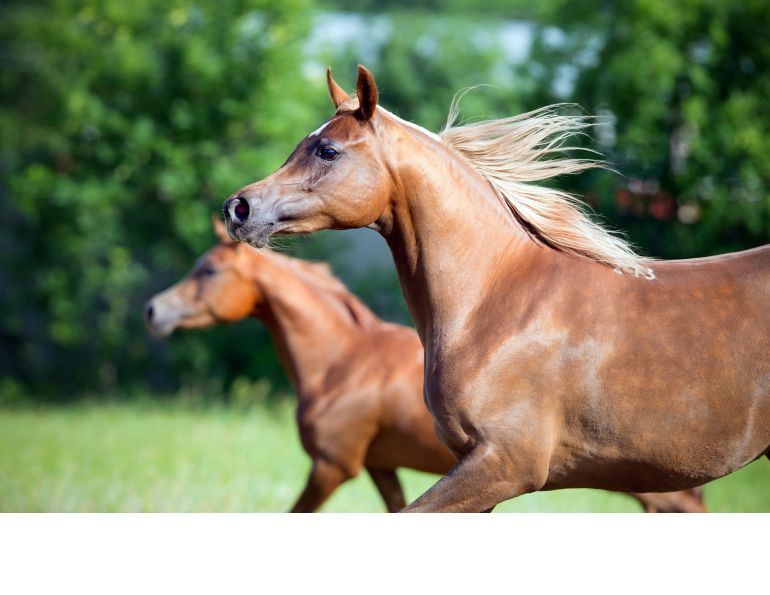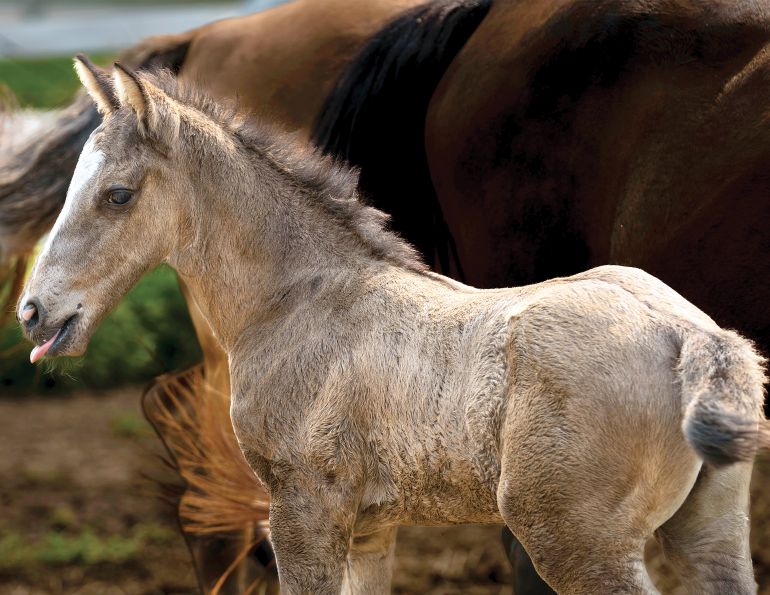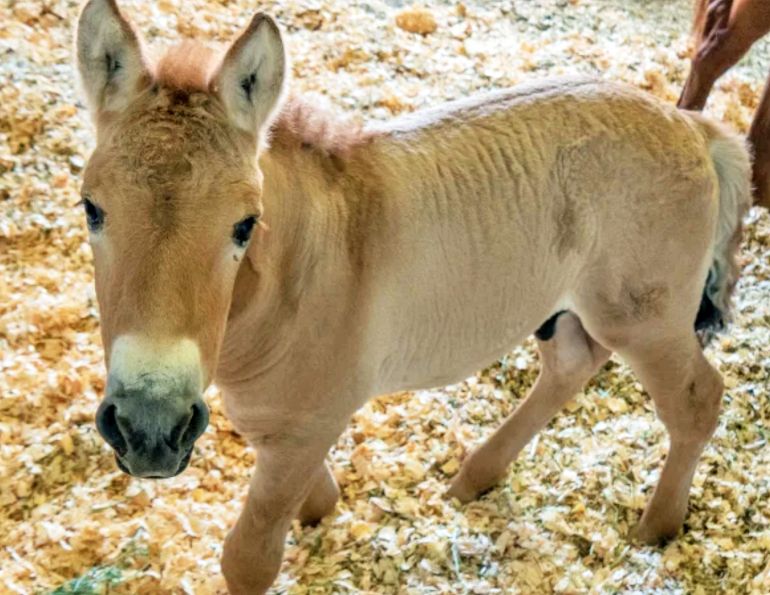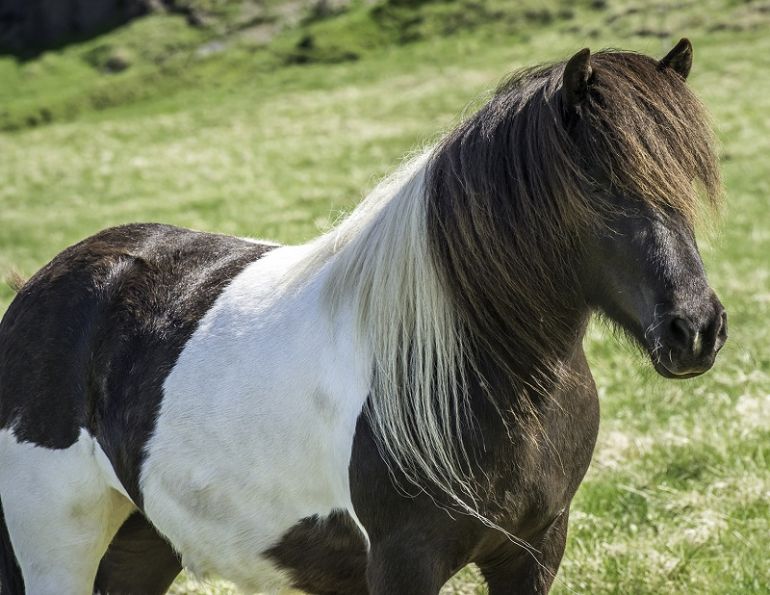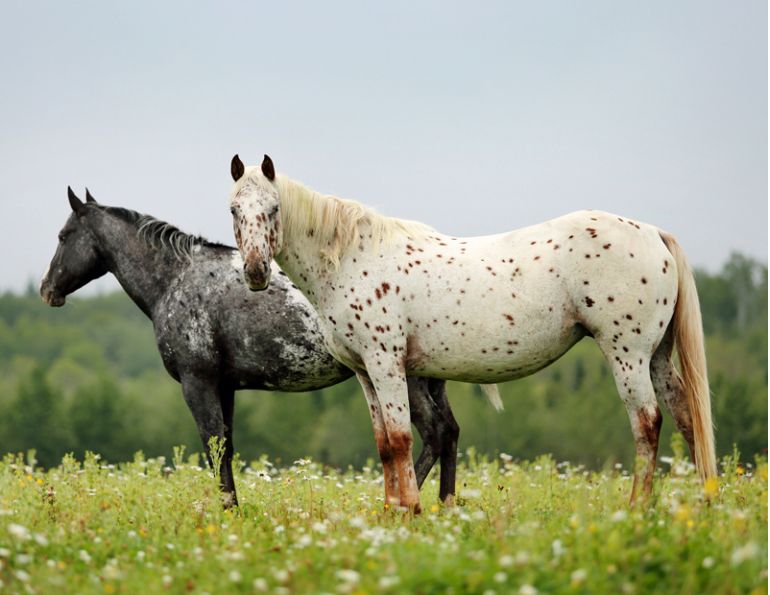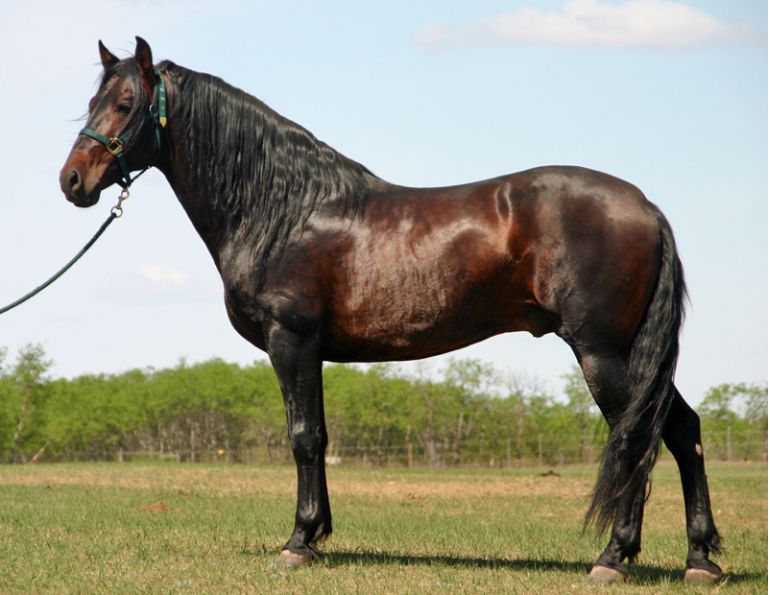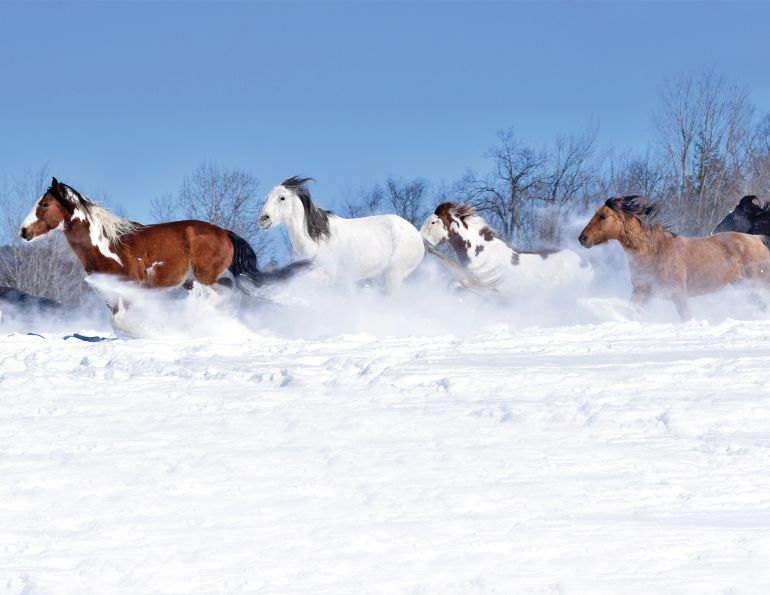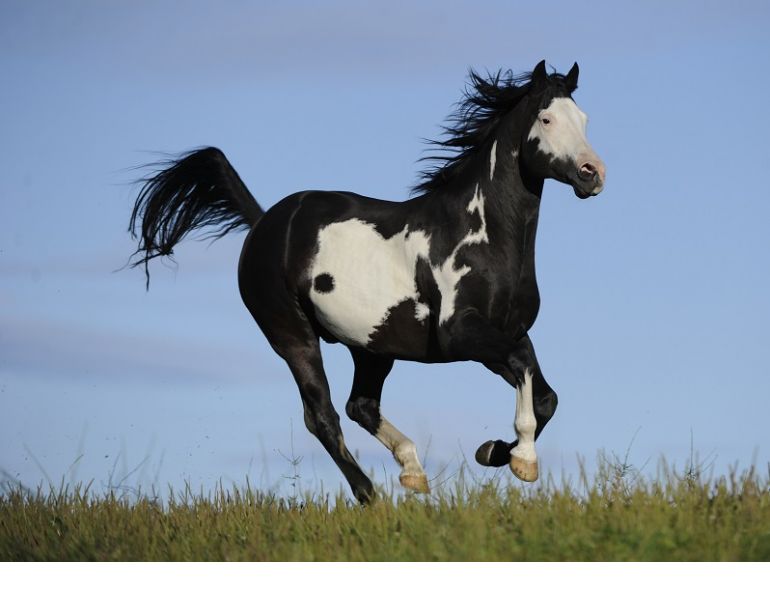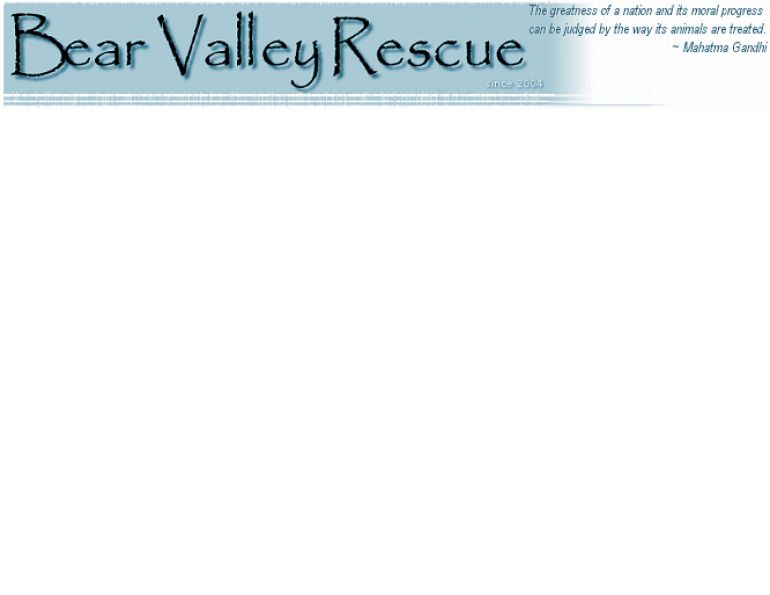By Caitlin MacDonald
“A man is only as strong as his horse.” — Ancient saying
Qatar has been a show horse, a broodmare, and a logger in the British Columbia interior. After the end of her shift as a carriage horse in downtown Victoria, she changes roles again — this time an eager riding horse, cooling off along the roadside beach of the Juan de Fuca Strait. Her draft horse bulk belies her gait; even after a day of pulling, she arches her neck and trots with forward action, calm and confident along the busy road, aware she is being admired by onlookers. Qatar, or “Kitty Kat” as she is affectionately called, exemplifies the strength, versatility, and happy disposition of the Percheron horse.

Percherons are still commonly seen at parades and shows. Here, they make a fine display at a parade in the inner harbour of Victoria, BC. Photo: Robin Duncan
The Percheron demonstrates its quality of performance as a sport and pleasure horse in addition to its better-known role in transportation and agricultural work. The breed is distinguished by an elegance, style, and alertness typical of a light horse, but with the calm temperament of a large draft.
The Percheron is of notable intelligence, and working with one immediately reveals their sweet and accepting disposition. But these calm and gentle giants are by no means lazy or slow. The Percheron is in no way constrained or made sluggish by his strength, power, and size: he boasts his mass exuberantly; his flash, scope and propulsion lend him an imposing drama.
Related: Celebrating the Clydesdale
To witness a Percheron is to witness the horseflesh of history. The Percheron is society’s steady partner, always withstanding the changing demands of the times. No matter the task, the Percheron has risen to the occasion and excelled at whatever was asked of it. The breed has served as a cavalry horse, heavy artillery horse, meat horse, coach, tram, and carriage horse, farm horse, logging horse, and saddle horse.
The Great Horse
The traits witnessed in today’s Percheron are the result of centuries of breeding for the ultimate war horse.
It is believed that the Percheron is the descendent of the medieval destrier, a type of horse bred specifically for the needs of the medieval knight. The destrier was much smaller than the modern day Percheron, but nevertheless was bred to be much heavier than other riding types and was referred to in the medieval era as The Great Horse due to its size and reputation.

A team of Percherons awaits harness before a parade in downtown Victoria, BC. Photo: Robin Duncan
The destrier was described as large, athletic, and powerfully muscled, with a short back, well-muscled loin, strong bone and arched neck; a straight or slightly convex profile with good width between the eyes.
Bulk was not the only consideration; while ample size was necessary to support the weight of armour, speed and athleticism was indispensable and flashy carriage and movement was also highly valued. Destriers were rare and expensive; they were associated with power and privilege, and they were bred for qualities that advertised the fact that they carried nobility. Substance without sluggishness was the major consideration; the destrier had to bear heavy burdens over long periods of time, as well as move quickly over shorter distances, as would be required in a charge or joust. He had to be calm and steady amongst the chaos of battle, but also quick and alert. He had to be trainable enough to perform advanced battlefield movements, and he had to be hardy and resilient. These qualities led to the destrier’s success as a war horse, and to the continued development of The Great Horse as a military mount.
The Eastern Influence
Perhaps the best known influence of the Percheron breed is that of the Arabian. In 732 A.D., the renowned Frankish cavalry of Charles Martel fought the cavalry of the Umayyad Caliphate during the Battle of Poitiers of central France. The French captured the mounts of the defeated Moorish army, thereby introducing Arabian and Barb bloodlines to French breeding stock.
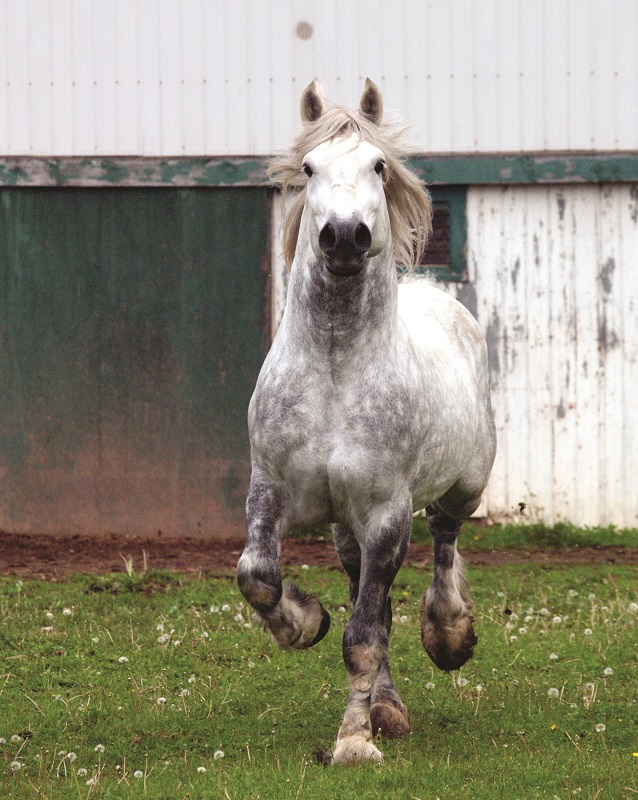
Jiggs, a Percheron stallion at Shady Creek Farm in Pleasant Valley, Nova Scotia, exhibits the Arabian influence in both profile, carriage and movement. Photo: Pam MacKenzie
Recognizing the quality of the Arabian and Barb as war horses, the French bred them with their own destriers, hoping to impart some of the athleticism, endurance, and hardiness of their enemy’s desert mounts. This Eastern influence is still evident in the profile of many Percherons, and some claim that it is the Arabian blood that gives the Percheron its high degree of intelligence, its refinement, and its resilience to extreme climates.
Related: The Gorgeous Gypsy Vanner Horse
Spanish blood was also an influence in the development of the military Percheron, when the Comte de Perche and later Robert, Comte de Rotrou, bred Andalusian stallions to Percheron mares after the First Crusade in 1092-99, as Andalusians had a long history as Greek cavalry mounts.
In 1715, the first Royal stud farm was created in Normandy to develop and produce horses specifically for military standard and quota, and the Percheron continued to be perfected as a military breed. Le Haras de Pin made two notable Arabian-cross studs available to Le Perche breeders: Godolphin and Gallipoly. Gallipoly sired the most famous Percheron stallion, Jean le Blanc, foaled in 1823 at Mauvres-sur-Huisne, a stud to which all of today’s Percheron bloodlines trace directly back to.
From War to Work
As the warhorse gradually ceded the battlefield to new technology, the Percheron began to dominate new roles.
The Haras du Pin continued to develop and sculpt the Percheron breed for other uses. Percherons were increasingly desired for use as “diligence” horses. This job required a horse to trot from seven to ten miles per hour pulling a heavy stage coach. The Percheron had the endurance to manage this day in and day out, and the breed’s commonly occurring grey and white colouring was preferred because it offered visibility at night. The breed has always been noted for having good feet and strong bone, which were necessary for hard work on pavement.
Percherons are a mainstay in the horse-drawn carriage business. Photo: Robin Duncan
A primarily agricultural region, Le Perche horseman also began breeding the Percheron into a heavier draft horse. As trade and transportation grew, so did the need for these heavier horses. The farmers had not only bred a workhorse of considerable strength and size that could work all day on the farm, they had created a horse that could haul heavy loads from docks and railheads, and one that was better suited to pulling French omnibuses, the public transportation of the day.
The North American need for heavy horses grew alongside transportation and industry, and the good reputation of French livestock increased the demand. The livestock of Le Perche region was highly respected, and Percheron horses were sought for import in large numbers for rural and urban work. They were referred to as French Drafts, Normans, Norman-Percherons, and some just as Percherons. While understood and recognized as a distinct breed, no studbook or registry was established until 1875, when the National Association of Importers and Breeders of Norman Horses was launched in Illinois. By the time the second volume of the stud book was published the name was altered to “Percheron-Norman.” In a matter of just a few years the hyphenated version became simply “Percheron.”
Related: Passionate About the Paint Horse
Shortly afterwards, a studbook specifically for the Percheron was established in France, separate from the French Draft Registry. While all Percherons would be accepted as French Drafts, it was now official that the opposite was not necessarily true.
Today, to be included in the French Percheron stud book, the horse must be bred in one of the four Departments of the region of Le Perche: Sarthe, Eure-et-Cher, Loire-et-Cher, or L’Orne.
Beginnings in Canada
It is generally claimed that the first Percheron horse was imported into Canada in 1816. This horse was known as the McNitt horse, taking the name from his owner, James Mcnitt, who purchased him after his importation.
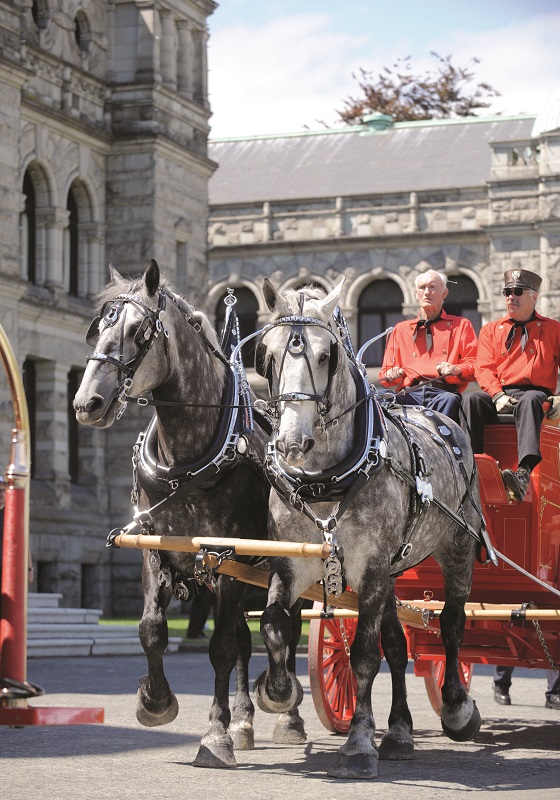
A team of greys on the grounds of the BC Legislature in Victoria, BC before a downtown parade. Photo: Robin Duncan
The Canadian Percheron Association was incorporated in 1907; the Percheron was so popular that by 1930 the government census showed that there were three times as many registered Percherons as the other four draft breeds of the time combined.
Related: Irresistible Iberian Horse
Characteristically solid and sound, their immense popularity is explained in anecdotal evidence of the time, with farm owners praising them as very easy keepers in comparison to other breeds, with unrivalled endurance and temperament. Those that used them for urban work preferred the Percheron for its style and elegance, and cited the Percheron’s quality of hooves and clean legs (with little to no feathering) as requiring less upkeep than the Clydesdale’s. The Percheron was used as a work horse on the farm and in the cities, and made a final appearance as a war horse when it was employed to haul munitions during World War I.
Many Percherons were imported to Canada in the last half of the 19th century and importations continued up until World War II. By that time, much of the Percheron breeding stock in France had been taken by the Germans for military transport; the heavy draft type Percheron was then bred even heavier and stockier in order to feed a starving wartime population. French imports dwindled at this time, as the coarser, heavy draft meat-bred Percherons were not preferred by domestic breeders, which favoured a more athletic type. The last known French Percheron import to Canada was by Bill and Opal Lucas in 1975; the grey stallion Farman was the first to be imported to Canada from France since 1930, and proved a valuable outcross to domestic lines.
The Modern Percheron
After enjoying many years as the most prominent draft breed in North America, the Percheron once again submitted amiably to the whims of history. Percheron numbers dropped considerably, but they were still a mainstay in Amish communities, and continued to be sculpted.
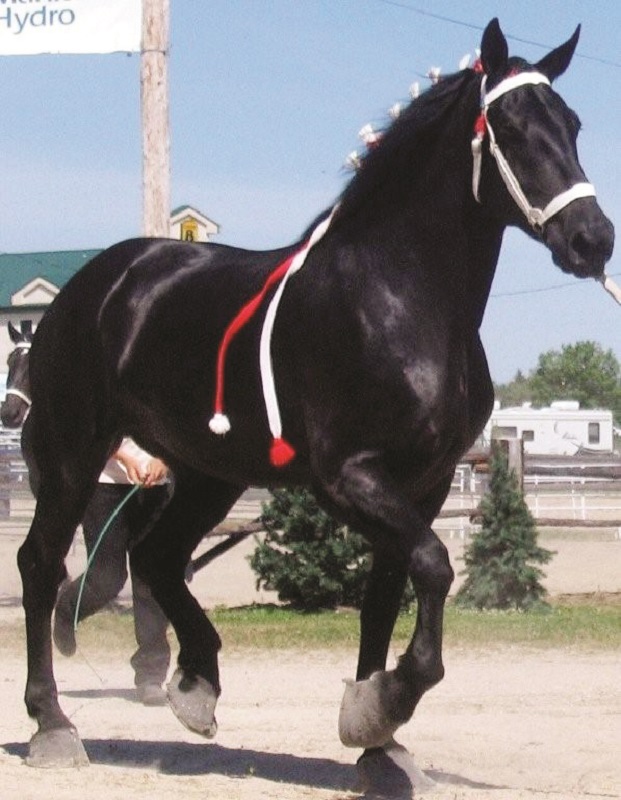
The Percheron is very conformationally sound, with a short back and level croup, a well muscled hip, and crested neck, and solid depth of body. Photo: Marnie Anderson
The success of domestic breeding programs earned the Canadian Percheron an impressive reputation.
“The Percheron ‘mafia’ was within a 50 mile radius of Calgary,” said Pete Thumond of Sage Hill Percherons. At one point, says Thumond, the “highest concentration of Percherons in the world was in Alberta. 90 percent of Percherons in the US trace back to Alberta stock. The best Percherons in the world come from Alberta because during the era of the tractor when nobody wanted these big horses, breeding was kept up at the government stud farms — the federal experimental farms. They tried new types of grain, forage, and quality livestock.”
One of the major forerunners and prominent influence of the modern Percheron was the well known Saskatchewan stallion Justamere Showtime. During his career, his considerable height, stretch, and shallow rib were thought to be too extreme; nevertheless, he was referred to as “the Percheron of the future,” and his contribution to the modern Percheron speaks for itself: Thumond noted that in 1983, of 512 registered head, 300 horses traced their ancestry to Justamere Showtime.
Related: A Carriage Ride Through History
The question of ideal type for the Percheron depends entirely on the intended usage: whether for show, work, or pleasure.
Regardless, the breed standard describes a horse between 15 to 19 hands tall with a range in weight from 1600 pounds to 2400 pounds. Known affectionately as “blacks and greys”, these colours are predominant, but sorrel and bay appear occasionally and are registerable. The head is broad between the eyes with alert, pointed ears and a large prominent eye showing intelligence and spirit. The neck is long and considerably arched; the shoulder is long with a slope of about 45 degrees to enable free movement and natural carriage. Percherons should have a wide, deep chest which provides strong heart and lung capacity. Well defined withers, a short back, a deep girth, a long, somewhat level croup, big, well-rounded hip, and powerful muscling in the lower thigh are also characteristic. For power and action, the horse should stand with the hocks fairly close together. There should be little feathering. The breed standard states that all this should rest on top of a large foot of blue horn with a wide heel. The Percheron should have bright, forward, and eye catching movement.
Show, Work, and Play
With its trademark elegance, the Percheron is always at home in the show ring. Percherons are shown in-hand and in a wide array of driving disciplines from single cart to multiple hitch. They are commonly seen in commercial hitches, which have helped to raise the breed’s profile.
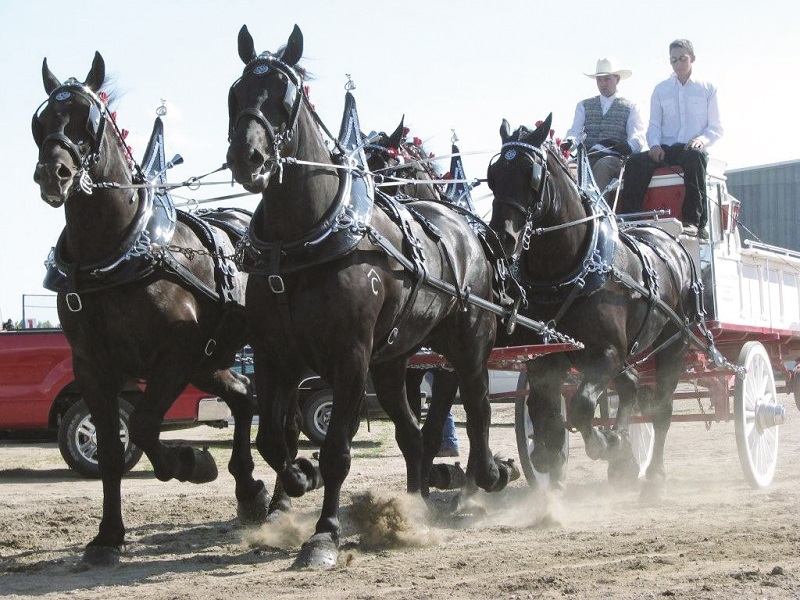
A team of “blacks and greys” are a flashy choice for cart, carriage or wagon, and are very popular in commercial hitches. Photo: Marnie Anderson
Percherons are currently experiencing a revival in popularity as people rediscover the breed’s versatility. The Percheron is still gainfully employed as an agricultural, transportation, and pleasure horse. Those in the horse-drawn carriage industry favour Percherons today for the same reasons the city teamsters of yesterday preferred them: they are trainable, calm, friendly, eye catching, easy keepers, and happy workers. These qualities also make them popular in Amish communities and amongst those die-hard horse farmers who prefer working a team of Percherons in the field rather than driving a tractor.
Those who are able to win private contracts for sustainable logging against clear-cutters still commonly use Percherons for horse-logging, a job the Percheron has been employed in since it’s importation to Canada.

Keith Casey mowing with his Percheron team. Photo: Pam MacKenzie
And on Prince Edward Island, Percherons are still used for the harvest of Irish Moss. Harnessed to a drag or scoop, they navigate rocky shore areas that cannot be accessed by boat, salvaging the valuable seaweed for its carrageenan, which brings approximately $1 million dollars to the Island annually.
Related: Forged in Fire - When Horses Answered the Alarm
Percherons are still widely seen at horse-pulling competitions, which offer large purses to the teamster whose horses can pull the heaviest load over the longest distance, and have been exported to Japan in large numbers for the popular Ban-ei competitions, draft horse races similar to horse-pulls.
The Percheron’s athleticism makes it an excellent riding horse relative to other draft breeds, and Percheron crosses are increasingly desired as sporthorses. “A top horse at the Olympics a few years back was a Percheron-cross bred in Australia,” noted Bruce Roy, founder of the Draft Horse Journal and Percheron pedigree specialist.
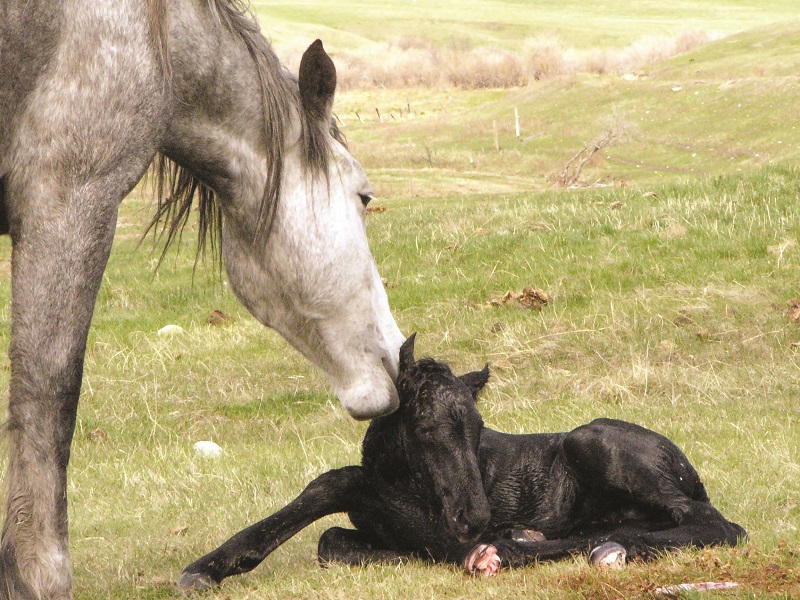
A Percheron mare tends to her new foal. The Percheron matrilineal line is very strong, and mares are good producers. Photo: Courtesy of Lucasia Ranch
The Percheron matrilineal line is very strong; and Percheron mares bred to light horses will produce strong sporthorses, often with conformational faults corrected.
“Draft horse breeders have always been breeding for structural soundness, not for performance. Because of the heavy work Percherons were bred for, if they weren’t conformationally correct, they wouldn’t last,” said Roy.
Roy once sold a Percheron stallion to an Italian breeder who aimed to improve the conformation of his Warmbloods. Another popular cross, the Spanish-Norman, has resulted from attempts to reproduce the medieval destrier type by crossing Percherons with Andalusians.
Pride of Place
Working with a Percheron is such a pleasure in any capacity that they quickly win a person’s allegiance. There is no task above or beneath the Percheron; they willingly toil with power, intelligence and grace.
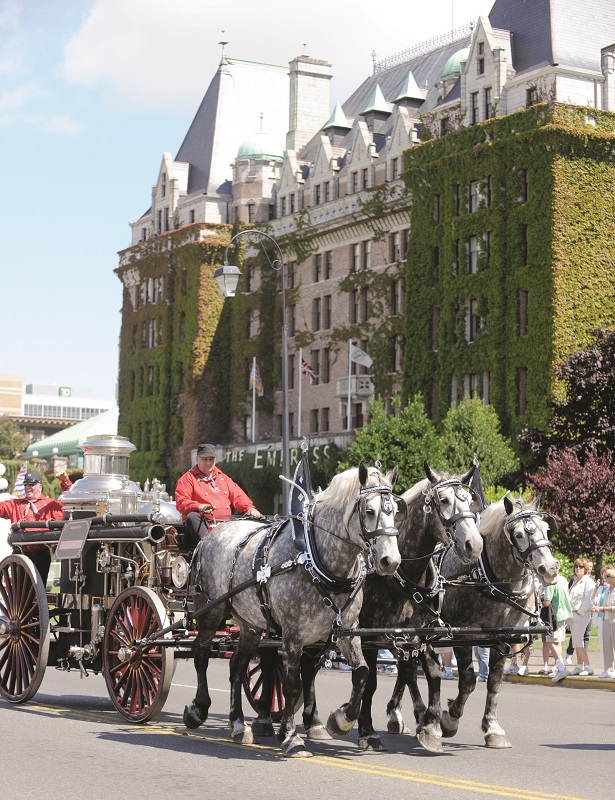
Reminiscent of bygone days, a Percheron three-horse n team pulls an antique fire engine in Victoria, BC. Photo: Robin Duncan.
A Percheron’s pride is subtle: present not in attitude but in the honour of his lineage. The perseverance, adaptability, versatility, and easy disposition of these horses have not only made them society’s indispensable partner throughout history, but an indispensable partner for the future.
Related: History of the Draft Horse: The Muscle-Men of the Horse World
Related: Jake the Logging Horse Hero
Main photo: Percherons being driven three-abreast at a parade in downtown Victoria, BC. Credit: Robin Duncan Photography -



